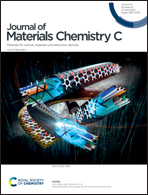Electronic influence of ultrathin aluminum oxide on the transistor device performance of binary indium/tin oxide films†
Abstract
Heterostack thin-film transistors (TFTs) with an active layer comprising indium-, tin-, and aluminum oxide (ITAO) were fabricated using atomic layer deposition (ALD) to investigate the influence of aluminum oxide on the TFT performance parameters. Deposition of the quaternary heterostacks was accomplished at 200 °C using trimethylindium (TMI), tetrakis(dimethylamino)tin (TDMASn), trimethylaluminum (TMA), and water as oxidizing agent. By adjusting the number of Al2O3 cycles, while keeping the ratio of In2O3 to SnO2 constant, ITAO films with a well-defined Al2O3 content were obtained as confirmed by X-ray photoelectron spectroscopy (XPS). The stacked structure of the thin-films, as well as the uniform thickness was verified by high resolution transmission electron microscopy (HRTEM). The thin-film composition of the ternary ITAO semiconductors could be correlated to their electronic performance. Reducing the aluminum oxide content from three to one cycles in the atomic layer deposition experiment reveals a significant increase in the saturation mobility of nearly 300%, however at the expense of other important transistor parameters. The thus optimized ITAO thin-film exhibits a decent saturation mobility (μsat) of 2.28 cm2 V−1 s−1, a threshold-voltage (Vth) of 6.8 V, a high current on/off ratio (IOn/IOff) of 9.0 × 105, and a low subthreshold swing (SS) of 365.5 mV dec−1, using a large width to length ratio (W/L = 500). Furthermore, the incorporation of aluminum oxide leads to an increase in performance stability towards exposure to background irradiation under transistor operation. The critical transistor performance parameters were altered only to a minor extent when irradiated with energies of 2.0 eV to 3.7 eV. This confirms the enhanced light stability of the TFTs, through employing a wide-band gap material as part of the semiconducting layer.



 Please wait while we load your content...
Please wait while we load your content...